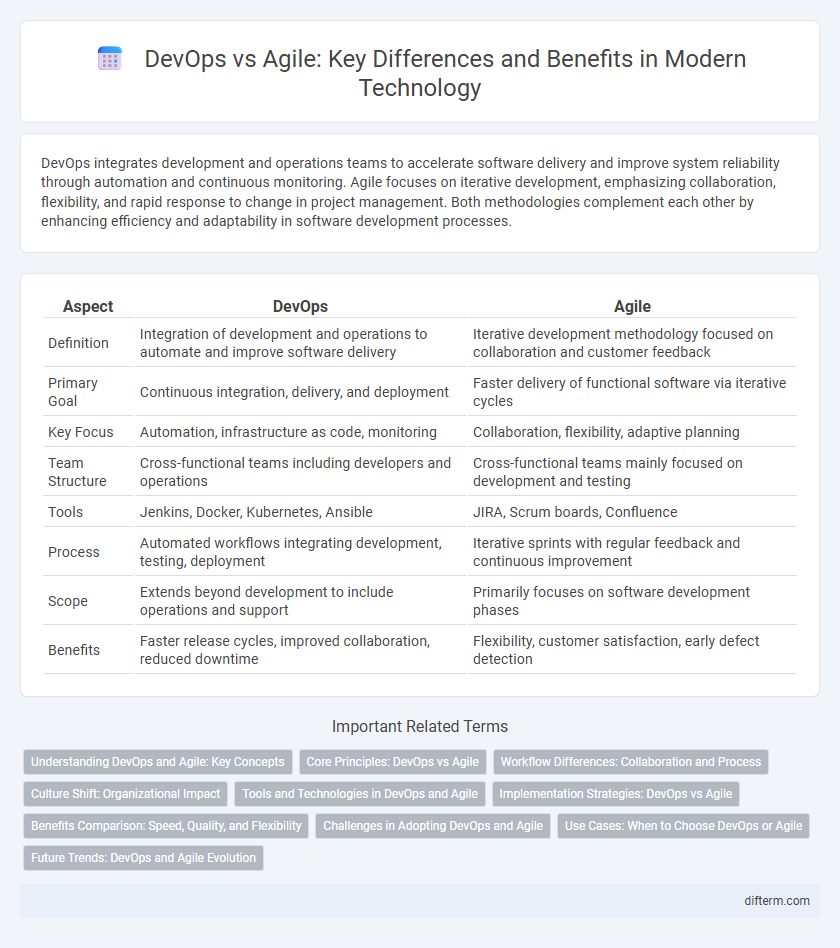DevOps integrates development and operations teams to accelerate software delivery and improve system reliability through automation and continuous monitoring. Agile focuses on iterative development, emphasizing collaboration, flexibility, and rapid response to change in project management. Both methodologies complement each other by enhancing efficiency and adaptability in software development processes.
Table of Comparison
| Aspect | DevOps | Agile |
|---|---|---|
| Definition | Integration of development and operations to automate and improve software delivery | Iterative development methodology focused on collaboration and customer feedback |
| Primary Goal | Continuous integration, delivery, and deployment | Faster delivery of functional software via iterative cycles |
| Key Focus | Automation, infrastructure as code, monitoring | Collaboration, flexibility, adaptive planning |
| Team Structure | Cross-functional teams including developers and operations | Cross-functional teams mainly focused on development and testing |
| Tools | Jenkins, Docker, Kubernetes, Ansible | JIRA, Scrum boards, Confluence |
| Process | Automated workflows integrating development, testing, deployment | Iterative sprints with regular feedback and continuous improvement |
| Scope | Extends beyond development to include operations and support | Primarily focuses on software development phases |
| Benefits | Faster release cycles, improved collaboration, reduced downtime | Flexibility, customer satisfaction, early defect detection |
Understanding DevOps and Agile: Key Concepts
DevOps integrates development and operations teams to automate and streamline the software delivery lifecycle, emphasizing continuous integration, continuous delivery (CI/CD), and rapid deployment. Agile focuses on iterative development, customer collaboration, and adaptive planning through frameworks like Scrum and Kanban, enabling fast response to change. Both methodologies enhance software quality and speed but differ in scope: Agile targets project management and development processes, while DevOps bridges development with IT operations for end-to-end workflow optimization.
Core Principles: DevOps vs Agile
DevOps centers on collaboration between development and operations teams, emphasizing continuous integration, continuous delivery (CI/CD), and automation to accelerate the software release cycle. Agile focuses on iterative development, customer collaboration, and adaptive planning to enhance flexibility and responsiveness to changing requirements. Both methodologies prioritize improving product quality and team efficiency but apply distinct core principles to achieve faster, reliable software delivery.
Workflow Differences: Collaboration and Process
DevOps integrates development and operations teams through continuous integration and continuous delivery (CI/CD) pipelines, emphasizing automation and real-time monitoring to enhance workflow efficiency. Agile focuses on iterative development cycles and cross-functional team collaboration using frameworks like Scrum or Kanban, prioritizing adaptability and frequent feedback. The primary workflow difference lies in DevOps' end-to-end automation of deployment processes versus Agile's incremental delivery with strong stakeholder interaction.
Culture Shift: Organizational Impact
DevOps fosters a culture shift by emphasizing collaboration between development and operations teams, breaking down traditional silos to accelerate delivery cycles. Agile promotes adaptability and iterative progress, encouraging cross-functional teams to respond swiftly to change and customer feedback. Both approaches drive organizational impact by cultivating transparency, continuous improvement, and shared responsibility across departments.
Tools and Technologies in DevOps and Agile
DevOps leverages tools such as Jenkins, Docker, Kubernetes, and Ansible to automate continuous integration, delivery, and infrastructure management, emphasizing collaboration between development and operations teams. Agile utilizes project management and collaboration tools like Jira, Trello, and Confluence to foster iterative development, rapid feedback, and adaptive planning within cross-functional teams. Both methodologies integrate version control systems like Git to maintain code quality and enable seamless collaboration across the software development lifecycle.
Implementation Strategies: DevOps vs Agile
DevOps implementation strategies emphasize continuous integration, automated testing, and infrastructure as code to accelerate delivery and ensure system reliability. Agile implementation focuses on iterative development, regular stakeholder feedback, and adaptive planning to enhance team collaboration and product flexibility. Combining DevOps with Agile practices can optimize software development lifecycles by synchronizing rapid deployment with responsive project management.
Benefits Comparison: Speed, Quality, and Flexibility
DevOps accelerates software delivery by integrating continuous integration and continuous deployment, significantly reducing lead times and improving release frequency. Agile enhances product quality through iterative development and regular stakeholder feedback, ensuring alignment with customer needs and rapid defect resolution. Both methodologies boost flexibility, with DevOps streamlining infrastructure automation and Agile promoting adaptive planning and incremental value delivery.
Challenges in Adopting DevOps and Agile
Adopting DevOps poses challenges such as cultural resistance, lack of cross-functional skills, and toolchain integration complexities, which can hinder seamless collaboration. Agile faces difficulties in scaling frameworks across large enterprises, maintaining consistent communication among distributed teams, and balancing flexibility with formal project governance. Both methodologies require significant organizational change management to overcome entrenched silos and align continuous delivery with iterative development cycles.
Use Cases: When to Choose DevOps or Agile
DevOps is ideal for organizations seeking continuous integration and continuous delivery (CI/CD) to streamline software deployment and enhance collaboration between development and operations teams. Agile suits projects requiring adaptive planning, iterative development, and frequent customer feedback, particularly in dynamic environments with changing requirements. Choose DevOps when automation and infrastructure management are priorities, while Agile fits best for evolving product development with a focus on flexibility and responsiveness.
Future Trends: DevOps and Agile Evolution
Future trends in DevOps and Agile emphasize increased integration through AI-driven automation and continuous feedback loops, enhancing efficiency in software development lifecycles. Hybrid models combining Agile's iterative methodologies with DevOps' continuous deployment processes are expected to dominate enterprise IT strategies by 2026. Advancements in cloud-native technologies and microservices architecture will further accelerate the convergence of DevOps and Agile, fostering faster innovation and scalability.
DevOps vs Agile Infographic

 difterm.com
difterm.com